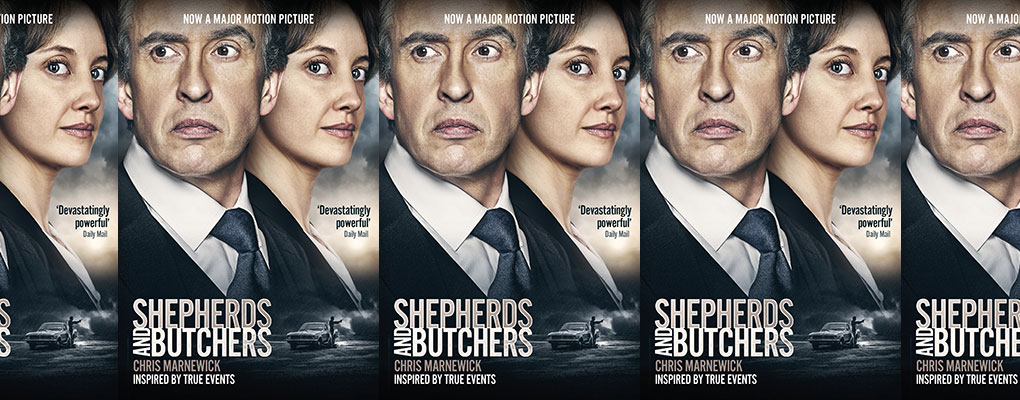Books
Extract: Shepherds and Butchers by Chris Marnewick
Chris Marnewick’s Shepherds and Butchers is a gripping true crime story set in apartheid South Africa – and now a critically acclaimed Netflix film starring Steve Coogan.
When Leon, a white 19-year-old prison guard working on death row commits an inexplicable act of violence, killing seven black men in a hail of bullets, the outcome of the trial – and the court’s sentence – seems a foregone conclusion.
Hotshot lawyer John Weber, played by Steve Coogan, reluctantly takes on the seemingly unwinnable case. A passionate opponent of the death penalty, John discovers that young Leon worked on death row in the nation’s most notorious prison, under traumatic conditions: befriending the inmates over the years while having to assist with their eventual execution.
As the court hearings progress, the case offers John the opportunity to put the entire system of legally sanctioned murder on trial. How can one man take such a dual role of friend and executioner, becoming both shepherd and butcher? Inspired by true events, this is the story that puts the death penalty on trial and changes history.
Read on for an extract from Shepherds and Butchers…
Shepherds and Butchers
by
Chris Marnewick
1 Palace of Justice, Pretoria
The Judge’s scarlet robes signified that this was a capital case, that he had the power of life and death. I watched the serious figure in the centre of the bench as he moved his high-backed chair slightly forward and picked up his reading glasses. His two Assessors, elderly gentlemen dressed in sombre suits, leaned back in their chairs. Their first task had been completed, helping the Judge to arrive at a verdict on the question of guilt or innocence. It remained for the Judge to announce the outcome and to explain the Court’s reasons.
‘The defendant may be seated,’ said the Judge. ‘The judgment will take some time.’
Leon Labuschagne sat down and almost disappeared behind the wood panelling of the dock where Nelson Mandela had stood trial on a charge of high treason more than twenty years earlier, his life similarly at stake. Mandela had escaped with his life, and is due to become our new President in a month’s time. The preparations for his inauguration brought back these memories.
It was October 1988, and it was spring in Pretoria. I was tired. The trial had run for only two weeks, but they had been hard weeks and there had been many anxious moments, long stretches of concentrated action, dark hours of nightmares and despair. I was exhausted; physically and emotionally drained by the effort. I turned slightly in my seat to look around.
Court C of the Palace of Justice was tattered, its furniture and fittings in dire need of refurbishment. Large flakes of paint hung from the high walls. Some of the bulbs in the antique light fittings lining the walls needed to be replaced. The once plush carpet was threadbare and worn through in areas of heavy traffic, its once sombre ox blood-red now faded to a dull pink. The wood-framed windows above the architraves bore the stains of many years’ worth of accumulated dust and grime and the droppings of the ubiquitous pigeons.
The Judge was Mr Justice J P van Zyl. He tested his voice by coughing softly behind his hand before he opened his bench book. Spectators in the back rows of the public gallery craned forward to hear. I sat at counsel’s table with my Junior on my left. Th e prosecutors were within whispering distance from me. A door slammed elsewhere in the building, its sound muted by the thick stone walls and the carpeting as the Judge started reading in measured tones.
‘The extraordinary defence in this case has its origins in a process of which very few details have been known until this trial – the execution of a condemned criminal by the State.’
I felt my concentration begin to wane as the performance stress started to abate. I had played my part in the trial. Th ere was nothing more I could do, in any event. They were either going to find Labuschagne guilty and sentence him to death, or they were going to acquit him. Either way, my job was done. For once I could afford to let my thoughts run free.
I thought of my childhood friend Oupa Venter. We were sitting in the shade of the camel thorn tree behind the kitchen of Welgedacht Primary School, taking a break from our sword and shield battles, Oupa playing the Roman centurion to my Spartacus. I never told him that according to the encyclopaedia we had on the farm the centurion was supposed to win and Spartacus was supposed to end up on a cross, broken and dehydrated. We were flicking seed pods, floating them in the air like pebbles on water. The only constant in our games was Oupa’s smile, his white teeth flashing in the light – whether he was on the winning or losing side, always that dashing smile.
I remembered the blond hairs on Oupa’s arms, bleached even whiter by exposure to the sun and contrasting with the tanned skin underneath. I felt my facial muscles tighten as I thought of his battered body, lying in his bed, with his blood spattered on the walls and the ceiling of his grandmother’s house in town. His sister and his grandmother had been murdered during the same frenzied attack that took his life. By then I was in high school, and had been overcome with curiosity. I went to look at the murder scene, a house in a dirt road on the poor side of Potgietersrus.
As I sat in Court C I could still see in my mind’s eye the photograph of Oupa’s murderer on the execution notice. It had been posted on the public notice board at the Magistrates’ Court. It was still there when I went for a job interview after I had finished school four years later. The photograph showed the murderer, a smiling man in his thirties, in a prison jacket. There was a number pinned across his chest – 1266. The notice said that Johannes Buchling had been executed for murder. I wondered if he was still smiling when they put the rope around his neck.
My father also appeared unbidden from the recesses of my memory, another smiling face in his thirties. I remembered the journey from Johannesburg to Pretoria in the car many years earlier, with my father driving and acting as tour guide at the same time. I had never been to Pretoria.
‘That is the place where they are going to hang van Buuren,’ he had said as we entered the city from the south. He pointed at the corner of a large building complex on the left. The words over the entrance gates were long for my not yet nine-year-old eyes, but I just managed to get them all before we passed the windowless corner of the last brown building.
PRETORIA SENTRAAL GEVANGENIS
PRETORIA CENTRAL PRISON
I remembered van Buuren, a suave, handsome young man wearing sunglasses, staring arrogantly at me from the front page of the Sunday paper. How could I have known at that time, during that miserable Johannesburg winter when I was racked with croup, that one day I would be the public prosecutor in the very same courtroom where the photograph had been taken?
I glanced up at the Judge – he was still dealing with preliminary matters – as I paged through the register on the table in front of me. I found the right year and scanned down the pages, one by one. There he was, immediately after Gideon Sibiya:
| No. | Date | Name | Judge | Place | Outcome | Date |
|---|---|---|---|---|---|---|
| 517 | 28.2.57 | Clarence Gordon van Buuren | Broome, J | Durban | Executed | 10.6.57 |
As I turned more pages of the Capital Cases Register, my eye fell on another name I recognised:
| 537 | 20.5.57 | Roland Roberts (EM) | J T van Wyk | Cape Town | Executed | 8.11.57 |
He had even made it into the Law Reports and I later had to study his case in Criminal Law 1 under the heading INSANITY. The letters EM next to his name intrigued me. I looked more closely at the other entries. There were other similar codes, and I deciphered them quickly. NM appeared the most frequently, Native Male. There were also lots of CMs, for Coloured Male. Occasionally there would be an EM, a European Male. I started looking into the register from a different angle. Why are there no IMs, Indian Males? I wondered. Yet I found one quickly. I also found two NFs on one page, Native Female. The search for an EF, European Female, did not take long either:
| 592 | 25.11.57 | Margaret Elizabeth Rheeder (EF) | A G Jennett | Port Elizabeth | Executed | 6.5.58 |
Rheeder was hanged for poisoning her husband. I remembered the case well. The hanging of a woman always made the headlines, and my reading skills had advanced by one year since van Buuren. Before I could find a CF or an IF, Judge van Zyl started to describe the execution process. I had to pay attention once more. The Judge turned a page and stared at the skylight above our heads briefly before he spoke. The clouds had returned for the judgment, great banks of them rushing over Pretoria in waves, their effect felt in the courtroom as alternating sheets of light and gloom as the judge read in and out of the paragraphs of the judgment. It was a judgment crafted for inclusion in the Law Reports. In the pages of the Death Sentence Register I found an escape from the tedium of words that were read and not spoken, of ideas that were emasculated by legalese and precedent.
‘The execution process can only be described as a dramatic and traumatic experience for everyone involved.’
The stress of the trial lingered in my robes as a sweaty mix of fear and apprehension.
Have you watched Shepherds and Butchers on Netflix UK yet? Let us know your thoughts in the comments below!
1 Comment
Join the discussion
Please note: Moderation is enabled and may delay your comment being posted. There is no need to resubmit your comment. By posting a comment you are agreeing to the website Terms of Use.


A Gritty difficult portrayal of lives, in a bleak background featuring stuff not often seen so truly.